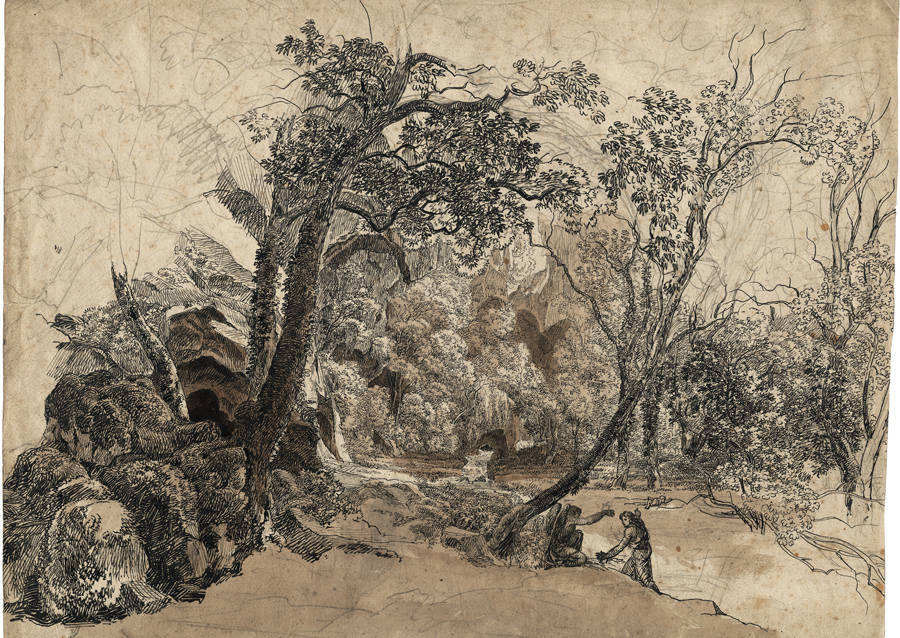Loading the page ...
Friedrich Salathé
(1793 Binningen near Basel – 1858 Paris)
Landscape with Hagar and Ishmael; the Angel shows Hagar the Spring. Pen and black ink over pencil, brown wash. 31.5 x 42 cm. Ca. 1815–18.
This splendid, exceptionally intense landscape occupies a special place in the graphic œuvre of Friedrich Salathé, as it is one of very few works with a Biblical theme. Trained as a painter by Peter Birmann in Basle, the young Salathé set off in the late summer of 1815 for Rome, where he was to live and work with brief interruptions until 1821. He soon developed close relations with the German and Swiss artists who resided in Rome. Salathé’s wide circle of friends included such reputable older artists as Joseph Anton Koch, Johann Martin von Rohden and Johann Christian Reinhart, who had come to Italy in the previous century, as well as colleagues of his own age, like Carl Barth, Samuel Amsler and Joseph Sutter. Through his association with Carl Friedrich von Rumohr, Salathé also maintained close ties with the Nazarenes and their circle.
Despite the great variety of artistic influences that Salathé found in Rome the artist soon went his own way. Like Friedrich Nerly (see cat. no.17), who was also a protégé of von Rumohr’s, his interest was almost exclusively devoted to landscapes, which was the reason why Salathé initially felt himself more drawn to such older landscape artists as Koch and Reinhart. Salathé explored the Mediterranean landscape during trips to southern Italy and hikes through the Roman Campagna, gradually gaining an increasing measure of artistic freedom. He developed a dynamic and powerful pen technique, which he skilfully combined with wash in order to capture the effect of light and atmosphere in a manner that was true to nature. This development reached its zenith in the years 1819–21, when Salathé executed a number of landscape studies and oil sketches of the utmost spontaneity and freshness.
The present drawing, which was probably done early in his Roman period, marks a brief episode in Salathé’s artistic career. Probably under Koch’s influence, the artist did a number of works in which he combined a landscape scene drawn from nature with an Old Testament theme or a pastoral staffage. These are only incidental efforts, as the Biblical theme plays a completely subordinate role in the carefully arranged composition and his protagonists are lost amid the wild and luxuriant vegetation that surrounds them. The concentrated and richly differentiated penwork, which is imposed on a hasty preliminary pencil drawing, reveals not only the example of Samuel Birmann, but also the influence of Johann Christian Reinhart’s landscape drawings. The robust and energetic hatching and cross-hatching in the foreground forms a dense and intricate vegetation pattern that becomes progressively finer and more delicate as it recedes into the middle distance and background, giving rise to a subtle transparency and lightness. The two towering tree trunks in the foreground act as a window that effectively draws in the gaze of the beholder. Salathé’s brilliant use of lavis produces vivid chiaroscuro contrasts and a beguiling atmospheric effect. One can almost scent the freshness of the cool and shady hollow. The draughtsman has skilfully emphasized the contrast between the sketchily indicated terrain in the foreground and the precise rendering of the distant background. Despite its great artistic freedom each element of the composition is subordinated to a rational inner harmony which is the result of a consistent and uncompromising study of nature. Like few other German artists of his day Salathé raised the appeal of the infinito to a deliberate stylistic principle in his graphic work.
The present drawing is illustrated in the exhibition catalogue Ein Zeichner der Romantik. Friedrich Salathé, edited by Y. Boerlin-Brodbeck, G. Gerkens, D. Riccardi, Basel-Lübeck-Stuttgart 1988, p. 63, fig. 23.
